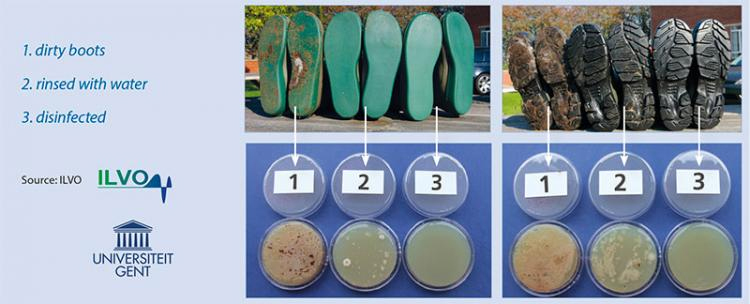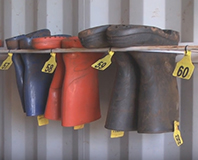Read the latest information on
Foot-and-mouth disease
Dirty boots can pose a very real risk to your property. People can unintentionally carry pest or disease-causing organisms on unwashed footwear, bringing them on to your farm without even realising it.
Soil-borne pests (like phylloxera, anthrax, Panama disease) and weed seeds are carried in dirt and mud. Pieces of infected plant material, manure and soil itself can carry diseases directly from one farm to the next.
A very simple way to manage this biosecurity risk is to ensure that visitors and staff who need to access your production areas thoroughly wash and disinfect their footwear.
In particular, high risk visitors who have been on other farms in the area recently should be asked to clean their shoes or change their footwear before moving onto your property.
People who are simply dropping in at the house and not coming into contact with your crops or livestock are a low risk and do not need to do this.
There are three simple rules when allowing visitors and workers to wear their own footwear in your production areas:

The top panel shows the soles of shoes with two different tread patterns after three steps: dirty, washed with water and disinfected. The bottom panel shows the organisms that grow from samples taken at each of the steps. Acknowledgement: reproduced with the permission of CID LINES.
Before washing, use a strong bristled brush to remove all visible debris. Boots should be free of dirt, mud, manure and plant material before using the footbath. These kinds of organic matter quickly contaminate the water and prevent the disinfectant from killing germs, so the boots need to be generally clean before you wash and disinfect.
The footbath should be a container which allows easy access. Ensure the container can fit a large boot so that the liquid saturates all parts of the footwear. Adding some soap or detergent to the water can clean better than using water alone. If shoes were very dirty to begin with, use the scrubbing brush while standing in the soap solution to thoroughly clean the soles of the shoe.

Sometimes it’s more practical to have a supply of shoes available for visitors or workers to wear on farm.
An alternative to washing boots every time someone enters or exits a production area is to provide visitors or workers with a change of shoes (e.g. gumboots) or disposable shoe covers that are only worn in the production areas. This will minimise the chance of transferring diseases, pests or weeds both on and off your property.
The boots will still need to be washed to keep them generally clean, but because they are only being worn in the production area they will not be a source of new diseases, pests or weeds.
Footbaths are a useful and inexpensive method of cleaning footwear before entering and exiting production areas of a property. To set up a footbath station you will need:
Set up each footbath station on a flat surface.
Scrubbing brushes and scraping tools should be provided to guests to assist with cleaning.
After the footbaths have been used, dispose of the water and decontaminant away from production areas and water sources. Take note of label instructions for disposal of the decontaminant.
For more information about disinfectants registered for use in Australia you can search PubCRIS, the APVMA’s Public Chemical Registration Information System, using ‘disinfectant’ as the search term. Go here and scroll down to see the results.
If you click on ‘Export CSV’ at the top right of the list of products, an Excel spreadsheet will be downloaded which includes information about recommended uses for the product. Alternatively, if you click on the ‘View details’ tab, and then then “Host/pest’ tab you’ll see the product uses. For example, you will know if the product is for use on vehicles, or hard surfaces, animal stalls, hands, minor surgery equipment, irrigation equipment, footwear and so on.